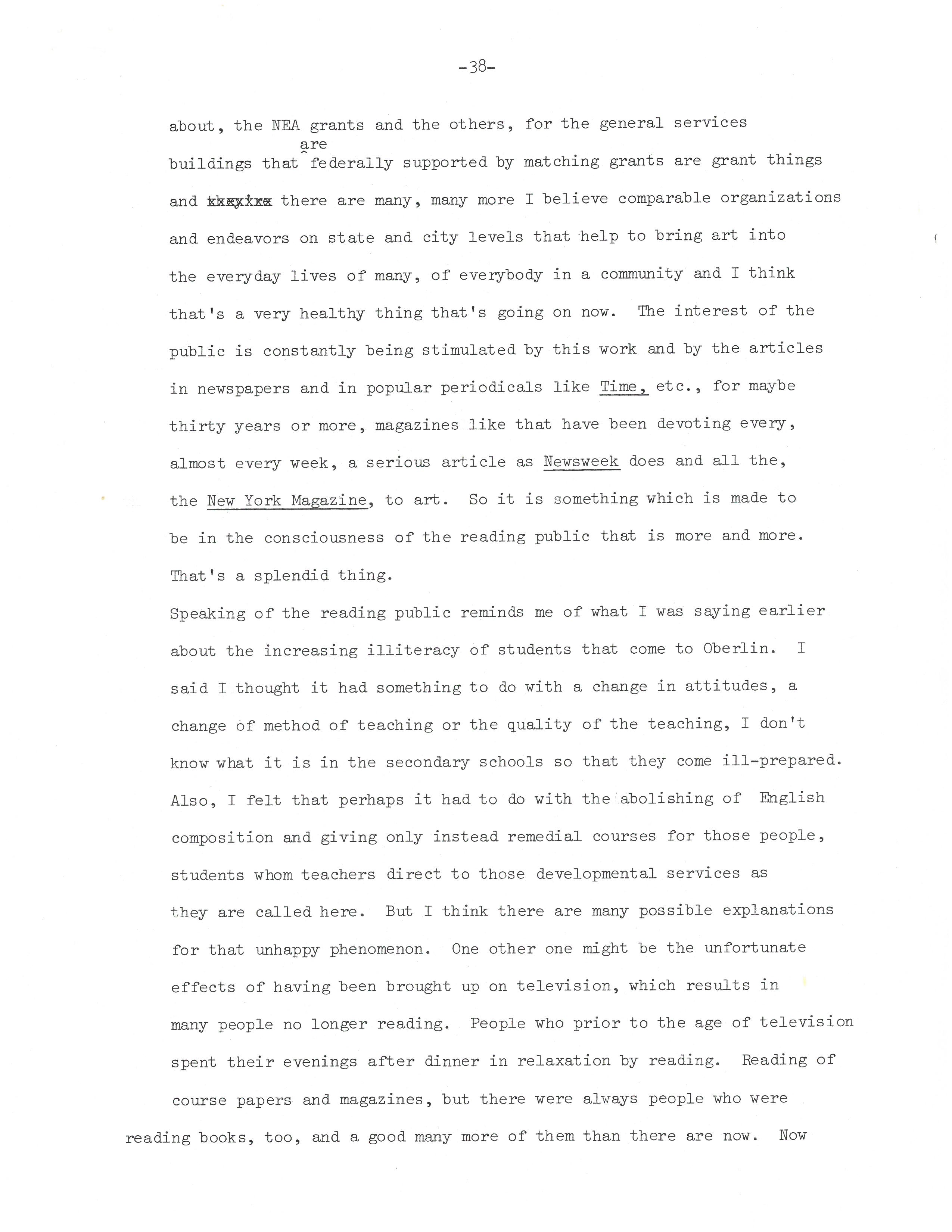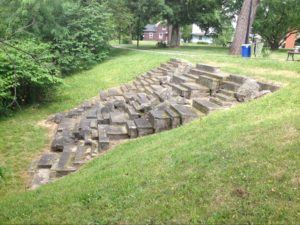
Cass Gilbert’s original 1917 building is on the left, and the Venturi Addition, which is checkered, was added in 1977.
[1] Robert Venturi explained his addition to the 1917 Allen Memorial Art Museum (AMAM), originally designed by Cass Gilbert, in the AMAM Bulletin alongside two tributes to Ellen Johnson. He writes, “Adding to a building by Cass Gilbert is difficult because his architecture is very good and comparisons are inevitable. Adding to the Allen Memorial Art Museum is particularly difficult because you are tampering with what has become at Oberlin an icon: adding a wing to the Art Museum is like drawing a mustache on a Madonna. It is difficult too, to add to a completed composition — a wing on a symmetrical renaissance villa, like a bowler hat on a Venus, will never look correct… We tried to make it respond on the outside to interior needs when necessary or appropriate, and, as Gilbert achieved a complex harmony with a small midwestern town, so we tried to harmonize with his masterpiece, in ways not too obvious” (Robert Venturi, “Plain and Fancy Architecture by Cass Gilbert and the Addition to the Museum by Venturi and Rauch,” in Allen Memorial Art Museum Bulletin, Vol. 34, No. 2, 1976-77, pp. 83-104. Source, accessed 21 June 2016).
[2] Athena Tacha, Spear’s wife, taught a course, “Form in Nature,” in 1973 which also explored the ideas of public art. Tacha’s first outdoor public sculpture was constructed in Oberlin’s Vine Street Park, perhaps due to Johnson’s influence. Streams is in the center of town, an environmentalist piece in the same park with memorials to Martin Luther King, Jr., John Brown, and the Oberlin-Wellington Rescue (Biographical Summary, Oberlin College, Source, 5 May 2016).
[3] Elizabeth McClelland, Cosmic Rhythms: Athena Tacha’s Public Sculpture (The Collier Printing Company: Wooster, Ohio, 1998), 5.
[4] The entirety of Tacha’s manifesto cannot be found; but its excerpted entry in Cosmic Rhythms reads:
“Most artists act within the limits of their own little world where they play the revolutionaries, ruminating on the ontological problems of art and splitting hairs in pseudo-philosophical jargon. They feel gratified when other colleagues acclaim their “revolutions,” when the closed ring of critics and museum people approve their doings, when the small clique of art-dealers manages to plug them into the general capitalistic machinery… They found pride in shocking the ignorant public (“épater le bourgeois”), and are still quite content to address a limited circle of connoisseurs who have learned to digest all extravagances, to the point of buying canned “Merda d’artista.” In turn, this situation has had a stifling effect on art, rendering it a largely self-feeding, super-refined and ruminating process. Much contemporary art is turned in on itself, gradually dissolving into thin air, while the age-long human problems–death, suffering, the mystery of life, the unknown of the universe–are more than ever present… The greatest problem today, or rather the greatest obstacle to the solution of most problems, is the tremendous imbalance in the distribution of wealth and knowledge–worse than ever in the past, in spite of our claims to democracy…. Wretchedly inadequate public education, politically oriented newspapers, and commercial television preserve the public’s intellectual stagnation, condition its state and opinions, and gear its standards to the “average” person, so conveniently gullible for the capitalistic system… They [the artists] are the major humanizing agents of society. They must make every effort to open their art, intellectually and financially, to the masses; take it out of the museums and galleries and bring it into people’s life. Critics should try to attract the large public, to help it understand and enjoy art, to bridge the gap between the avant garde artist and the common man…. The artists can play a leading role in this information war, as they own the power of the image.”
Piero Manzoni created “Merda d’artista” [Artist’s Shit], an exhibit of ninety cans, “which he offered for sale at the current price of gold.” His provocative gesture was meant to highlight the commercialization and absurdity of the price of art (Elizabeth McClelland, Cosmic Rhythms, 21-22).
[5] Elizabeth McClelland, Cosmic Rhythms, 21.
[6] Ellen H. Johnson.
[7] Earlier in the interview, Spear asked, “What do you think about the often-said charge that modern art is elitist and really not for the public? Do you think art really is for the general public and can it be taught to them?” (Interview conducted by Richard Spear, Box No. 1, Record Group 30, Ellen Johnson Papers, Series: II, O. C. A.).
[8] Spear asked, referencing Johnson’s recollection of a conversation with Claes Oldenberg in 1962, “Do you think the new interest in ‘public art‘ is a response to that, or more simply elitist art put outdoors? … Do you think the artist working out of doors has more of a responsibility by definition to the public? The common public?” To which Johnson replied, “He does if he feels that he does. I don’t think he does unless he feels that he does.” Johnson consistently uses “he/him/his” pronouns when referring to artists generally, which is surprisingly given her own position and focus on women artists (Interview conducted by Richard Spear, Box No. 1, Record Group 30, Ellen Johnson Papers, Series: II, O. C. A.).
[9] Likely “Tension Arches,” a sculpture by Athena Tacha, Johnson’s close friend and colleague, and Spear’s wife.Tension Arches was Tacha’s first outdoor sculpture (Outdoor Sculptures and Monuments in Greater Cleveland, Source, accessed 4 May 2016.; McClelland, Cosmic Rhythms, 34).
[10] Likely what is now the Tower City Center on West Huron Avenue in Public Square.
[11] Grants from the National Endowment for the Arts. Richard Spear and Johnson talk earlier in their conversation about her seat on multiple panels for the NEA (Interview conducted by Richard Spear, Ellen Johnson Papers, Series II, Box No. 1, O. C. A.).



